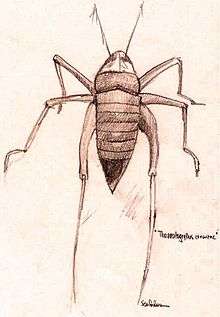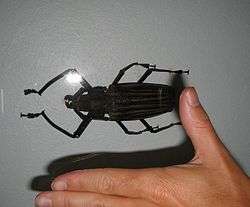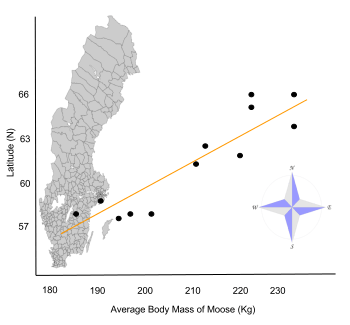Island gigantism

Island gigantism or insular gigantism is a biological phenomenon in which the size of an animal isolated on an island increases dramatically in comparison to its mainland relatives. Island gigantism is one aspect of the more general "island effect" or "Foster's rule", which posits that when mainland animals colonize islands, small species tend to evolve larger bodies, and large species tend to evolve smaller bodies. With the arrival of humans and associated predators (dogs, cats, rats, pigs), many giant as well as other island endemics have become extinct.
Possible causes
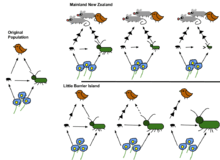
Large mammalian carnivores are often absent on islands because of insufficient range or difficulties in over-water dispersal. In their absence, the ecological niches for large predators may be occupied by birds, reptiles or smaller carnivorans, which can then grow to larger-than-normal size. For example, on prehistoric Gargano Island in the Miocene-Pliocene Mediterranean, on islands in the Caribbean like Cuba, and on Madagascar and New Zealand, some or all apex predators were birds like eagles, falcons and owls, including some of the largest known examples of these groups. However, birds and reptiles generally make less efficient large predators than advanced carnivorans.
Since small size usually makes it easier for herbivores to escape or hide from predators, the decreased predation pressure on islands can allow them to grow larger.[1][lower-alpha 1] Small herbivores may also benefit from the absence of competition from missing types of large herbivores.
Benefits of large size that have been suggested for island tortoises include decreased vulnerability to scarcity of food and/or water, through ability to survive for longer intervals without them, or ability to travel longer distances to obtain them. Periods of such scarcity may be a greater threat on oceanic islands than on the mainland.[4]
Thus, island gigantism is usually an evolutionary trend resulting from the removal of constraints on the size of small animals related to predation and/or competition.[5] Such constraints can operate differently depending on the size of the animal, however; for example, while small herbivores may escape predation by hiding, large herbivores may deter predators by intimidation. As a result, the complementary phenomenon of island dwarfism can also result from the removal of constraints related to predation and/or competition on the size of large herbivores.[6] In contrast, insular dwarfism among predators more commonly results from the imposition of constraints associated with the limited prey resources available on islands.[6] As opposed to island dwarfism, island gigantism is found in most major vertebrate groups and in invertebrates.
Territorialism may favor the evolution of island gigantism. A study on Anaho Island in Nevada determined that reptile species that were territorial tended to be larger on the island compared to the mainland, particularly in the smaller species. In territorial species, larger size makes individuals better able to compete to defend their territory. This gives additional impetus to evolution toward larger size in an insular population.[7]
A further means of establishing island gigantism may be a founder effect operative when larger members of a mainland population are superior in their ability to colonize islands.[8]
Island size plays a role in determining the extent of gigantism. Smaller islands generally accelerate the rate of evolution of changes in organism size, and organisms there evolve greater extremes in size.[9]
Examples
Examples of island gigantism include:
Mammals
Many rodents grow larger on islands, whereas carnivores, proboscideans and artiodactyls usually become smaller.
Eulipotyphlans
| Example | Binomial name | Native range | Current status | Continental relatives |
|---|---|---|---|---|
| Corsican giant shrew | Asoriculus corsicanus | Corsica | Extinct (before 500 BC) | Red-toothed shrews |
| Balearic giant shrew | Asoriculus hidalgo | Majorca and Menorca | Extinct | |
| Sardinian giant shrew | Asoriculus similis | Sardinia | Extinct | |
Deinogalerix | Deinogalerix spp. | Gargano Island | Extinct (Late Miocene) | Moon rats |
Rodents
| Example | Binomial name | Native range | Current status | Continental relatives |
|---|---|---|---|---|
| Blunt-toothed giant hutia | Amblyrhiza inundata | Anguilla and Saint Martin | Extinct (Pleistocene) | Neotropical spiny rats |
.png) St Kilda field mouse | Apodemus sylvaticus hirtensis | St Kilda | Least Concern | Old World field mouse |
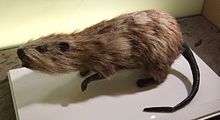 Tenerife giant rat | Canariomys bravoi | Tenerife | Extinct (Late Pleistocene) | African rufous-nosed rats |
Gran Canaria giant rat | Canariomys tamarani | Gran Canaria | Extinct (before AD 1500) | |
| Larger Jamaican giant hutia | Clidomys osborni | Jamaica | Extinct (Late Pleistocene) | Neotropical spiny rats |
| Plate-toothed giant hutia | Elasmodontomys obliquus | Puerto Rico | Extinct (c. 1 AD) | |
| Formentera black-tailed garden dormouse | Eliomys quercinus ophiusae | Formentera | Rare[10] | Garden dormouse |
| Minorcan giant dormouse | Hypnomys mahonensis | Menorca | Extinct | Leithiinae dormice |
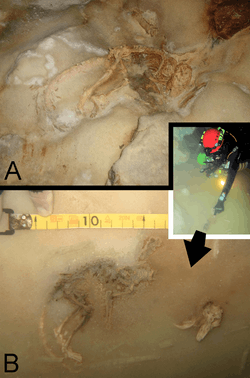 Majorcan giant dormouse | Hypnomys morpheus | Majorca | Extinct | |
| Sicilian giant dormouse | Leithia cartei | Sicily | Extinct | |
| Maltese giant dormouse | Leithia melitensis | Malta | Extinct | |
| Gargano giant voles | Mikrotia magna M. maiuscula M. parva | Gargano Island | Extinct (Early Pliocene) | Meadow voles |
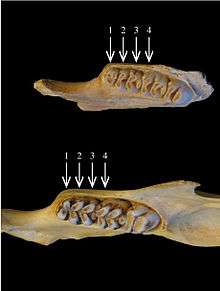 Flores giant rat | Papagamoys armandvillei | Flores | Near Threatened | True rats |
| Sulawesi giant rat | Paruromys dominator | Sulawesi | Least Concern | |
| Twisted-toothed mouse | Quemisia gravis | Hispaniola | Extinct | Neotropical spiny rats |
| Admiralty giant rat | Rattus detentus | Manus Island | Unknown / Likely threatened[11] | True rats |
| Congreso Island black rat population[12] | Rattus rattus | Congreso Island, one of the Chafarinas Islands | Least Concern | North African black rat |
| Arboreal giant hutia[13] | Tainotherium valei | Puerto Rico | Extinct | Neotropical spiny rats |
| Lesser Jamaica giant hutia | Xaymaca fulvopulvis | Jamaica | Extinct |
Lagomorphs
| Example | Binomial name | Native range | Current status | Continental relatives |
|---|---|---|---|---|
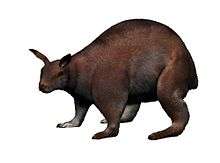 Minorcan giant lagomorph | Nuralagus rex | Menorca | Extinct (Middle Pliocene) | Alilepus (?) Trischizolagus (?) |
| Prolagus imperialis | Gargano Island | Extinct | Pikas | |
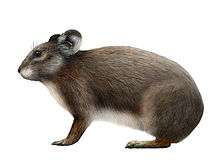 Sardinian pika | Prolagus sardus | Corsica, Sardinia and Tavolara | Extinct (c. AD 1800) |
Primates
| Example | Binomial name | Native range | Current status | Continental relatives |
|---|---|---|---|---|
| Hispaniola monkey | Antillothrix bernensis | Hispaniola | Extinct (before AD 1600) | Titis |
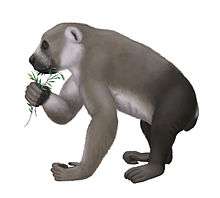 Gorilla lemur | Archaeoindris fontoynontii | Central Madagascar | Extinct (c. 350 BC) | Galagos, pottos and lorises |
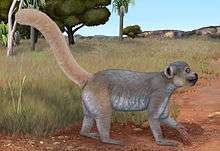 Baboon lemurs | Archaeolemur spp. Hadropithecus spp. | Madagascar | Extinct (before AD 1280) | |
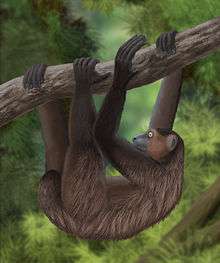 Sloth lemurs | Babakotia spp. Palaeopropithecus spp. | Western and Central Madagascar | Extinct (c. AD 1500) | |
| Haitian monkey | Insulacebus toussaintiana | Southwestern Haiti | Extinct | Titis |
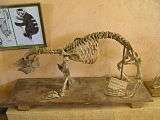 Koala lemurs | Megaladapis edwardsi M. grandidieri M. madagascariensis | Madagascar | Extinct (AD 1280-1420) | Galagos, pottos and lorises |
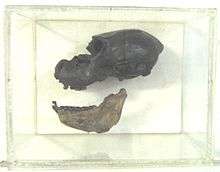 Cuban monkeys | Paralouatta marianae[14] P. varonai[14] | Cuba | Extinct (Pleistocene) | Titis |
| Jamaican monkey | Xenothrix mcgregori | Jamaica | Extinct |
Carnivorans
| Example | Binomial name | Native range | Current status | Continental relatives |
|---|---|---|---|---|
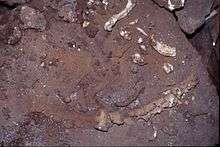 Sardinian giant otter | Megalenhydris barbaricina | Sardinia | Extinct (Late Pleistocene) | Otters |
Fossa | Cryptoprocta ferox | Madagascar | Vulnerable | Mongooses |
| Giant fossa | Cryptoprocta spelaea | Madagascar | Extinct |
Birds
Stem birds
| Example | Binomial name | Native range | Current status | Continental relatives |
|---|---|---|---|---|
 Balaur | B. bondoc | Hateg Island | Extinct (Late Cretaceous) | Jeholornis[15] |
Gargantuavis | G. philohinos | Southern France | Extinct (Late Cretaceous) | Patagopteryx (?) |
Ratites
| Example | Binomial name | Native range | Current status | Continental relatives |
|---|---|---|---|---|
Kiwis | Apteryx spp. | New Zealand | Variable | Proapteryx[lower-alpha 2] |
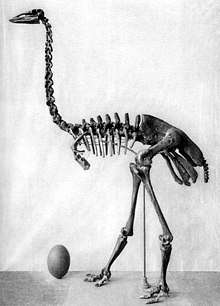 Larger elephant birds | Aepyornis spp. Vorombe spp. | Madagascar | Extinct (c. AD 1000) | |
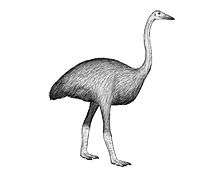 Lesser elephant birds | Mullerornis spp. | Madagascar | Extinct (c. AD 1260) | |
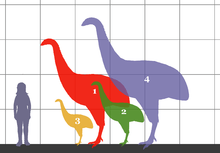 Moa | Anomalopteryx didiformis Dinornis spp. Emeus crassus Euryapteryx spp. Megalapteryx didinus Pachyornis spp. | New Zealand | Extinct (before AD 1445) | Tinamous |
Waterfowl
| Example | Binomial name | Native range | Current status | Continental relatives |
|---|---|---|---|---|
| New Zealand musk duck | Biziura delautouri | New Zealand | Extinct (after AD 1500) | Australian musk duck |
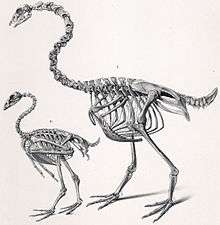 New Zealand geese | Cnemiornis calcitrans C. gracilis | New Zealand | Extinct | Cape Barren goose |
.jpg) Garganornis | G. ballmanni | Gargano and Scontrone islands | Extinct (Late Miocene) | Geese[17] |
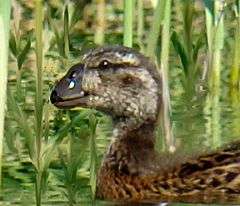 Turtle-jawed moa-nalo | Chelychelynechen quassus | Kauai | Extinct (c. AD 1000) | Ducks |
Small-billed moa-nalo | Ptaiochen pau | Maui | Extinct (c. AD 1000) | |
Maui Nui large-billed moa-nalo | Thambetochen chauliodous | Maui Nui | Extinct (c. AD 1000) | |
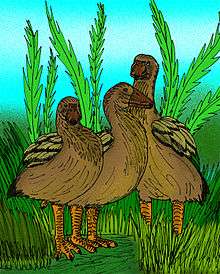 O'ahu moa-nalo | Thambetochen xanion | O'ahu | Extinct (c. AD 1000) | |
| Giant swan | Cygnus falconeri | Sicily and Malta | Extinct (Middle Pleistocene) | Mute swan |
| Scarlett's duck | Malacorhynchus scarletti | New Zealand | Extinct (after AD 1500) | Pink-eared duck |
Galliformes
| Example | Binomial name | Native range | Current status | Continental relatives |
|---|---|---|---|---|
| Pile-builder megapode | Megapodius molistructor | New Caledonia and Tonga | Extinct (c. 1500 BC) | Scrubfowl |
| Noble megapode | Megavitiornis altirostris | Fiji | Extinct | Galliformes |
New Caledonian giant megapode | Sylviornis neocaledoniae | New Caledonia and Isle of Pines | Extinct | |
Gruiformes
| Example | Binomial name | Native range | Current status | Continental relatives |
|---|---|---|---|---|
Red rail | Aphanapteryx bonasia | Mauritius | Extinct (c. AD 1700) | Rails |
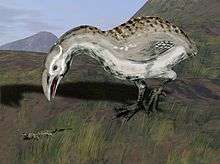 Adzebills | Aptornis defossor A. otidiformis | New Zealand | Extinct | Trumpeters |
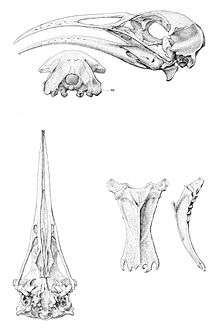 Hawkins's rail | Diaphanapteryx hawkinsi | Chatham Islands | Extinct (c. AD 1900) | Rails |
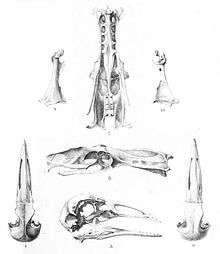 Chatham coot | Fulica chathamensis | Chatham Islands | Extinct (after AD 1500) | Coots |
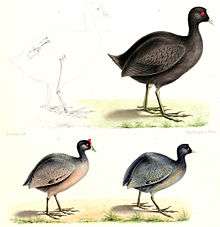 Mascarene coot | Fulica newtonii | Mauritius and Réunion | Extinct (c. AD 1700) | Eurasian coot |
| New Zealand coot | Fulica prisca | New Zealand | Extinct (after AD 1280) | Coots |
| Antillean cave rail | Nesotrochis debooyi | Puerto Rico and Virgin Islands | Extinct | Rails |
| Cuban cave rail | Nesotrochis picapicensis | Cuba | Extinct | |
| Haitian cave rail | Nesotrochis steganinos | Hispaniola | Extinct | |
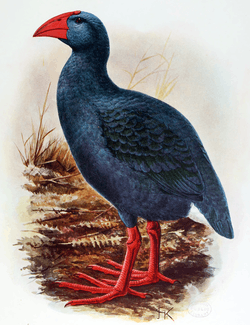 Réunion swamphen | Porphyrio coerulescens | Plaine des Cafres, Réunion | Extinct (c. AD 1730) | Purple swamphens |
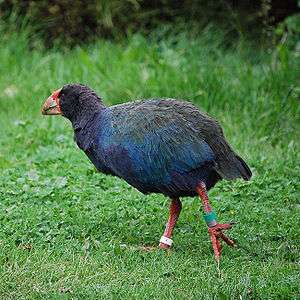 South Island takahē | Porphyrio hochstetteri | South Island, New Zealand | Endangered | Rails |
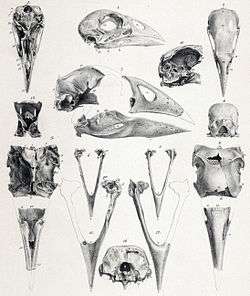 North Island takahē | Porphyrio mantelli | North Island, New Zealand | Extinct (before AD 1900) |
Suliformes
| Example | Binomial name | Native range | Current status | Continental relatives |
|---|---|---|---|---|
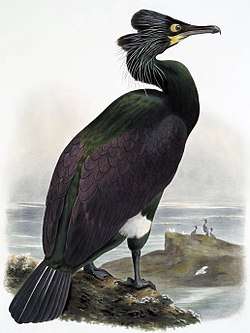 Spectacled cormorant | Phalacrocorax perspicillatus | Komandorski Islands | Extinct (c. AD 1850) | Double-crested cormorant |
Pigeons
| Example | Binomial name | Native range | Current status | Continental relatives |
|---|---|---|---|---|
Viti Levu giant pigeon | Natunaornis gigoura | Viti Levu, Fiji | Extinct | Crowned pigeons |
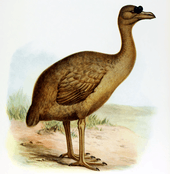 Rodrigues solitaire | Pezophaps solitaria | Rodrigues | Extinct (before AD 1778) | Nicobar pigeon |
Dodo | Raphus cucullatus | Mauritius | Extinct (c. AD 1662) |
Birds of prey
| Example | Binomial name | Native range | Current status | Continental relatives |
|---|---|---|---|---|
| Liko Cave golden eagle | Aquila chrysaetos simurgh | Crete | Extinct (Late Pleistocene) | Golden eagle |
| Giant crab-hawk[18] | Buteogallus borrasi | Cuba | Extinct | Great black hawk |
| Jamaican caracara | Caracara tellustris | Jamaica | Extinct | Caracaras |
| Eyles's harrier | Circus eylesi | New Zealand | Extinct (c. AD 1000) | Swamp harrier |
| Gargano Island eagles | Garganoaetus freudenthali G. murivorus | Gargano Island | Extinct (Late Miocene) | Aquila delphinensis |
| Giant hawk | Gigantohierax sp. | Cuba | Extinct | Hawks |
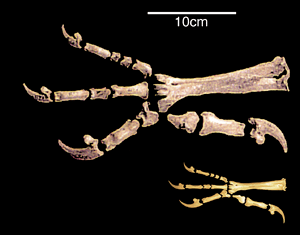 Haast's eagle | Harpagornis moorei | New Zealand | Extinct (c. AD 1400) | Little eagle Booted eagle |
| Titan-hawk | Titanohierax gloveralleni | Cuba, Hispaniola and the Bahamas | Extinct | Hawks |
Parrots
| Example | Binomial name | Native range | Current status | Continental relatives |
|---|---|---|---|---|
| Anakena Beach parrots | Two unnamed species | Easter Island | Extinct | Parrots |
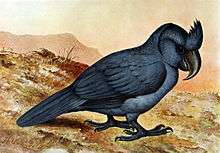 Broad-billed parrot | Lophopsittacus mauritianus | Mauritius | Extinct (c. AD 1680) | Psittaculine parrots |
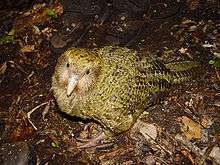 Kakapo | Strigops habroptila | New Zealand | Critically Endangered | Parrots |
Owls
| Example | Binomial name | Native range | Current status | Continental relatives |
|---|---|---|---|---|
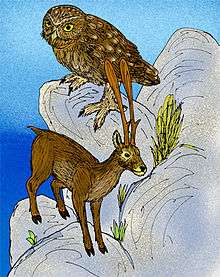 Cretan owl | Athene cretensis | Crete | Extinct (Pleistocene) | Little owl |
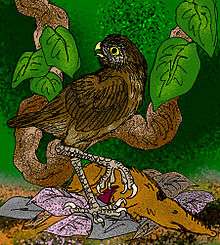 Cuban giant owls | Ornimegalonyx spp. | Cuba | Extinct (Pleistocene) | True owls |
Larger Gargano giant owl | Tyto gigantea | Gargano Island | Extinct (Late Miocene) | Barn owls |
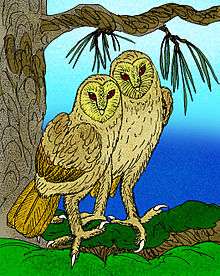 Andros Island barn owl | Tyto pollens | Andros Island, Bahamas | Extinct (before AD 1600) | |
| Rivero's barn owl | Tyto riveroi | Cuba | Extinct | |
Lesser Gargano giant owl | Tyto robusta | Gargano Island | Extinct (Early Pliocene) | |
Storks
| Example | Binomial name | Native range | Current status | Continental relatives |
|---|---|---|---|---|
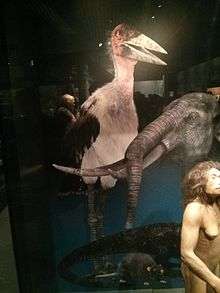 Flores flightless stork[19] | Leptostilos robustus | Flores | Extinct (Late Pleistocene) | Greater adjutant Lesser adjutant |
Caprimulgiformes
| Example | Binomial name | Native range | Current status | Continental relatives |
|---|---|---|---|---|
| New Zealand owlet-nightjar | Aegotheles novazelandiae | New Zealand | Extinct (c. AD 1200) | Australian owlet-nightjar |
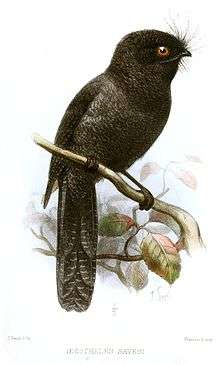 New Caledonian owlet-nightjar | Aegotheles savesi | New Caledonia | Critically endangered |
Passeriforms
| Example | Binomial name | Native range | Current status | Continental relatives |
|---|---|---|---|---|
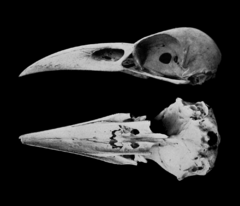 Chatham raven | Corvus moriorum | Chatham Islands | Extinct | New Zealand raven |
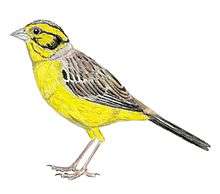 Long-legged bunting | Emberiza alcoveri | Tenerife | Extinct (after AD 1) | Cabanis's bunting Yellowhammer |
| Giant nukupu'u | Hemignathus vorpalis | Hawaii | Extinct (after AD 1000) | Finches |
| Tasmanian superb fairywren | Malurus cyaneus cyaneus | Tasmania | Least Concern | Superb fairywren |
| Kangaroo Island superb fairywren | Malurus cyaneus ashbyi | Kangaroo Island | Least Concern | |
| Stout-legged wren | Pachyplichas yaldwyni | South Island of New Zealand | Extinct | Passeriforms |
Capricorn silvereye | Zosterops lateralis chlorocephalus | Capricorn and Bunker Group of the Australian Great Barrier Reef | Unknown | Silvereye |
Reptiles
Pterosaurs
| Example | Binomial name | Native range | Current status | Continental relatives |
|---|---|---|---|---|
 Hatzegopteryx | H. thambema | Hateg Island | Extinct (Late Cretaceous) | Quetzalcoatlus |
Iguanids
| Example | Binomial name | Native range | Current status | Continental relatives |
|---|---|---|---|---|
Tongan giant iguana[20] | Brachylophus gibbonsi | Tonga | Extinct (c. 800 BC) | South American iguanids |
Fijian giant iguana [21] | Lapitiguana impensa | Fiji | Extinct (c. 1000 BC) | |
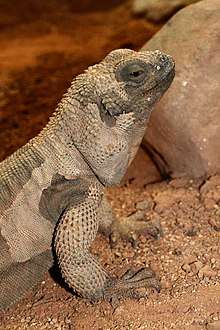 Angel Island chuckwalla | Sauromalus hispidus | Isla Ángel de la Guarda, Baja California | Near Threatened | Peninsular chuckwalla |
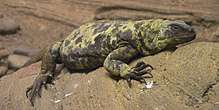 San Esteban chuckwalla | Sauromalus varius | San Esteban Island, Baja California | Endangered |
Geckos
| Example | Binomial name | Native range | Current status | Continental relatives |
|---|---|---|---|---|
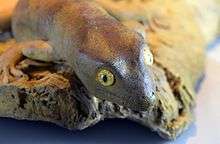 Delcourt's giant gekko | Hoplodactylus delcourti | New Zealand | Extinct (c. AD 1870) | Diplodactylid geckos |
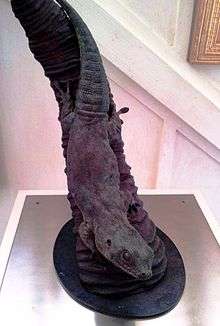 Rodrigues giant day gecko | Phelsuma gigas | Rodrigues | Extinct (c. AD 1850) | Day geckos |
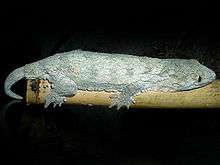 New Caledonian giant gecko | Rhacodactylus leachianus | New Caledonia | Least Concern | Diplodactylid geckos |
Skinks
| Example | Binomial name | Native range | Current status | Continental relatives |
|---|---|---|---|---|
| Vaillant's mabuya | Chioninia vaillanti | Cape Verde | Endangered | Mabuyas |
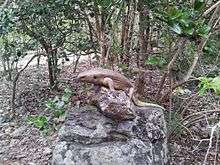 Mauritius giant skink | Leiolopisma mauritiana | Mauritius | Extinct (after AD 1600) | New Zealand Leiolopisma skinks |
 Cape Verde giant skink | Macroscincus coctei | Cape Verde | Extinct (after AD 1900) | Mabuyas |
| Terror skink | Phoboscincus bocourti | Île des Pins off New Caledonia | Endangered | Skinks |
Wall lizards
| Example | Binomial name | Native range | Current status | Continental relatives |
|---|---|---|---|---|
| La Palma giant lizard | Gallotia auaritae | La Palma | Critically endangered | Mediterranean sandrunner lizards |
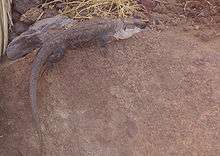 La Gomera giant lizard | Gallotia bravoana | Gomera | Critically endangered | |
Tenerife giant lizard[22] | Gallotia goliath | Tenerife | Extinct (c. AD 1500) | |
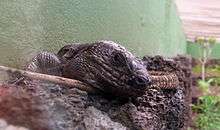 El Hierro giant lizard | Gallotia simonyi | El Hierro | Critically endangered | |
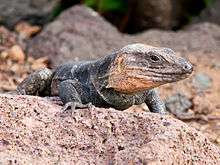 Gran Canaria giant lizard | Gallotia stehlini | Gran Canaria | Least Concern | |
Snakes
| Example | Binomial name | Native range | Current status | Continental relatives |
|---|---|---|---|---|
| Angel de la Guarda Island speckled rattlesnake | Crotalus mitchellii angelensis | Isla Ángel de la Guarda off Baja California | Least Concern | Speckled rattlesnake |
| Tadanae-jima striped snake population[23] | Elaphe quadrivirgata | Tadanae-jima island off Tokyo | Unknown | Japanese striped snake |
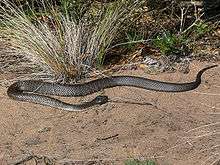 Island tiger snake populations | Notechis scutatus | Mount Chappell Island (Tasmania) and Williams Island, Hopkins Island and islands of the Nuyts Archipelago (South Australia)[24] | Least Concern[25] | Tiger snake |
| Isla Cerralvo long-nosed snake | Rhinocheilus lecontei etheridgei | Jacques Cousteau Island off Baja California Sur | Unknown | Long-nosed snake |
Dubious examples
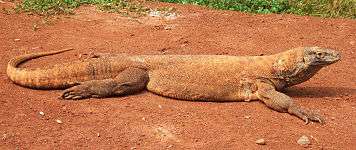 The Komodo dragon of Flores and nearby islands is the largest living lizard.
The Komodo dragon of Flores and nearby islands is the largest living lizard.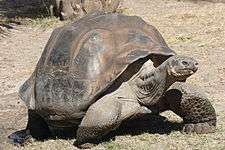 The largest tortoises in the world are found on the Seychelles and Galápagos Islands (example of the latter shown).
The largest tortoises in the world are found on the Seychelles and Galápagos Islands (example of the latter shown).
- The Komodo dragon and a similar (extinct) giant monitor lizard from Timor have been regarded as examples of giant insular carnivores. Since islands tend to offer limited food and territory, their mammalian carnivores (if present) are usually smaller than continental ones. These cases involve ectothermic carnivores on islands too small to support much mammalian competition. However, these lizards are not as large as their extinct Australian relative Megalania, and it has been proposed based on fossil evidence that the ancestors of these varanids first evolved their large size in Australia and then dispersed to Indonesia.[26] If this is true, rather than being insular giants they would be viewed as examples of phyletic gigantism. Nevertheless, given that Australia is sometimes viewed as the world's largest island, the former view may still be valid.
- Giant tortoises in the Galápagos Islands, the Seychelles, and formerly the Mascarenes and Canary Islands are often considered examples of island gigantism. However, during the Pleistocene, comparably sized or larger tortoises were present in Australia (Meiolania), southern Asia (Megalochelys), Madagascar (Dipsochelys), North[27] (Hesperotestudo) and South America[28] (Chelonoidis, the same genus now found in the Galápagos[29]), and on a number of other, more accessible islands.[27] In the late Pliocene they were also present in Africa[30] ("Geochelone" laetoliensis[31]). The present situation of large tortoises being only found on remote islands may reflect that these islands were discovered by humans fairly recently and have not been heavily populated, making their tortoises less subject to overexploitation.
Arthropods
Gastropods
| Example | Binomial name | Native range | Current status | Continental relatives |
|---|---|---|---|---|
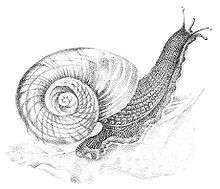 Kauri land snails | Paryphanta spp. Powelliphanta spp. | New Zealand | Near Threatened | Other rhytidids |
Flora
In addition to size increase, island grass plants may also exhibit "insular woodiness". The most notable examples are the megaherbs of New Zealand's subantarctic islands.[37]
| Example | Binomial name | Native range | Current status | Continental relatives |
|---|---|---|---|---|
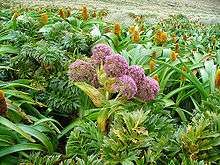 Campbell Island carrot | Anisotome latifolia | Campbell and Auckland Islands | Unknown | Apiaceae |
 Ross lily | Bulbinella rossii | Campbell and Auckland Islands | Unknown | New Zealand Maori Lily South African Yellow Cat-tail |
| Black-eyed daisy | Damnamenia vernicosa | Auckland and Campbell Islands | Unknown | Astereae |
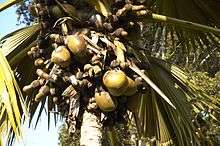 Coco de mer[38] | Lodoicea maldivica | Seychelles | Endangered | Borassoid palms |
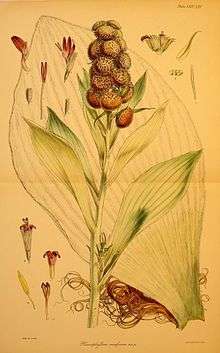 | Pleurophyllum criniferum | Antipodes, Auckland and Campbell Islands | Unknown | Cineraria |
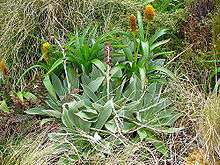 Silver-leaf daisy | Pleurophyllum hookeri | Macquarie Island, Auckland and Campbell Islands | Unknown | |
.jpg) Campbell Island daisy | Pleurophyllum speciosum | Campbell and Auckland Islands | Unknown | |
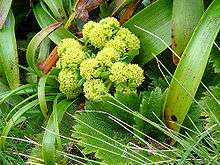 Macquarie Island cabbage | Stilbocarpa polaris | Macquarie Island and New Zealand subantarctic islands | Vulnerable | Araliaceae |
See also
Notes
References
- ↑ Herczeg, G. B.; Gonda, A. L.; Merilä, J. (2009-07-16). "Evolution of Gigantism in Nine-Spined Sticklebacks". Evolution. 63 (12): 3190–3200. doi:10.1111/j.1558-5646.2009.00781.x.
- ↑ Cooper, W. E.; Pyron, R. A.; Garland, T. (2014-01-08). "Island tameness: Living on islands reduces flight initiation distance". Proceedings of the Royal Society B: Biological Sciences. 281 (1777): 20133019. doi:10.1098/rspb.2013.3019. PMC 3896029. PMID 24403345.
- ↑ Yong, E. (2014-01-08). "Islands make animals tamer". Nature. doi:10.1038/nature.2014.14462.
- ↑ Jaffe, A. L.; Slater, G. J.; Alfaro, M. E. (2011-01-26). "The evolution of island gigantism and body size variation in tortoises and turtles". Biology Letters. 7 (4): 558–561. doi:10.1098/rsbl.2010.1084. PMC 3130210. PMID 21270022.
- ↑ Barahona, F.; Evans, S.E.; Mateo, J.A.; Garcia-Marquez, M.; Lopez-Jurado, L.F. (March 2000). "Endemism, Gigantism and Extinction in Island Lizards: The Genus Gallotia on the Canary Islands". Journal of Zoology. 250 (3): 373–388. doi:10.1017/s0952836900003101.
- 1 2 Raia, P.; Meiri, S. (August 2006). "The island rule in large mammals: paleontology meets ecology". Evolution. 60 (8): 1731–1742. doi:10.1111/j.0014-3820.2006.tb00516.x. Retrieved 2011-11-27.
- ↑ Keehn, J. E.; Nieto, N. C.; Tracy, C. R.; Gienger, C. M.; Feldman, C. R. (2013-08-27). "Evolution on a desert island: Body size divergence between the reptiles of Nevada's Anaho Island and the mainland around Pyramid Lake". Journal of Zoology. 291 (4): 269–278. doi:10.1111/jzo.12066.
- ↑ Lomolino, M. V. (2005-09-05). "Body size evolution in insular vertebrates: generality of the island rule". Journal of Biogeography. 32 (10): 1683–1699. doi:10.1111/j.1365-2699.2005.01314.x. Retrieved 2011-11-19.
- ↑ Filin, I.; Ziv, Y. (2004). "New Theory of Insular Evolution: Unifying the Loss of Dispersability and Body-mass Change" (PDF). Evolutionary Ecology Research. 6: 115–124.
- ↑ http://www.mapama.gob.es/es/biodiversidad/temas/conservacion-de-especies-amenazadas/LIRON_tcm7-20977.pdf
- ↑ Timm, R. M.; Weijola, V.; Aplin, K. P.; Donnellan, S. C.; Flannery, T. F.; Thomson, V.; Pine, R. H. (2016-04-12). "A new species of Rattus (Rodentia: Muridae) from Manus Island, Papua New Guinea". Journal of Mammalogy. 97 (3): 861–878. doi:10.1093/jmammal/gyw034.
- ↑ http://www.raco.cat/index.php/Orsis/article/viewFile/24434/24268
- ↑ Turvey, S. T. "A new genus and species of giant hutia (Tainotherium valei) from the Quaternary of Puerto Rico: an extinct arboreal quadruped?". Journal of Zoology. 270: 585–594. doi:10.1111/j.1469-7998.2006.00170.x.
- 1 2 MacPhee, R.D.E., Iturralde-Vinent, M.A., and Gaffney, E.S. (February 2003). "Domo de Zaza, an Early Miocene Vertebrate Locality in South-Central Cuba, with Notes on the Tectonic Evolution of Puerto Rico and the Mona Passage". American Museum Novitates. 3394 (1): 1–42. doi:10.1206/0003-0082(2003)394<0001:DDZAEM>2.0.CO;2.
- ↑ https://blogs.scientificamerican.com/tetrapod-zoology/late-cretaceous-animals-of-romania-s-hateg-island-a-more-complex-view/
- ↑ Worthy, Trevor H.; et al. (2013). Miocene fossils show that kiwi (Apteryx, Apterygidae) are probably not phyletic dwarves (PDF). Paleornithological Research 2013, Proceedings of the 8th International Meeting of the Society of Avian Paleontology and Evolution. Retrieved 16 September 2017.
- ↑ Pavia, M.; Meijer, H. J. M.; Rossi, M. A.; Göhlich, U. B. (2017-01-11). "The extreme insular adaptation of Garganornis ballmanni Meijer, 2014: a giant Anseriformes of the Neogene of the Mediterranean Basin". Royal Society Open Science. 4 (1): 160722. doi:10.1098/rsos.160722.
- ↑ Naish, Darren (2008-01-28). "Titan-hawks and other super-raptors". Tetrapod Zoology blog. ScienceBlogs LLC. Retrieved 2011-03-02.
- ↑ Meijer H. J. M.; Due, R. A. (2010-11-04). "A new species of giant marabou stork (Aves: Ciconiiformes) from the Pleistocene of Liang Bua, Flores (Indonesia)". Zoological Journal of the Linnean Society. 160 (4): 707–724. doi:10.1111/j.1096-3642.2010.00616.x.
- ↑ Pregill, G. K.; Steadman, D. W. (March 2004). "South Pacific Iguanas: Human Impacts and a New Species". Journal of Herpetology. 38 (1): 15–21. doi:10.1670/73-03A. JSTOR 1566081.
- ↑ Pregill, G. K.; Worthy, T. H. (March 2003). "A New Iguanid Lizard (Squamata, Iguanidae) from the Lare Quaternary of Fiji, Southwest Pacific". Herpetologica. The Herpetologists' League. 59 (1): 57–67. doi:10.1655/0018-0831(2003)059[0057:ANILSI]2.0.CO;2. ISSN 0018-0831.
- ↑ Maca-Meyer, N.; Carranza, S.; Rando, J. C.; Arnold, E. N.; Cabrera, V. M. (2003-12-01). "Status and relationships of the extinct giant Canary Island lizard Gallotia goliath (Reptilia: Lacertidae), assessed using ancient mtDNA from its mummified remains" (PDF). Biological Journal of the Linnean Society. Linnean Society of London. 80 (4): 659–670. doi:10.1111/j.1095-8312.2003.00265.x. Retrieved 2010-04-03.
- ↑ https://www.jstage.jst.go.jp/article/hsj2000/21/1/21_1_43/_pdf
- ↑ Keogh, J. S.; Scott, I. A. W.; Hayes, C. (January 2005). "Rapid and repeated origin of insular gigantism and dwarfism in Australian tiger snakes". Evolution. 59 (1): 226–233. doi:10.1111/j.0014-3820.2005.tb00909.x.
- ↑ http://www.iucnredlist.org/details/169687/0
- ↑ Turvey, S T.; Hocknull, S. A.; Piper, P. J.; van den Bergh, G. D.; Due, R. A.; Morwood, M. J.; Kurniawan, I. (2009-09-30). Turvey, Samuel T, ed. "Dragon's Paradise Lost: Palaeobiogeography, Evolution and Extinction of the Largest-Ever Terrestrial Lizards (Varanidae)". PLoS ONE. 4 (9): e7241. doi:10.1371/journal.pone.0007241. PMC 2748693. PMID 19789642. Retrieved 2012-02-09.
- 1 2 Hansen, D. M.; Donlan, C. J.; Griffiths, C. J.; Campbell, K. J. (April 2010). "Ecological history and latent conservation potential: large and giant tortoises as a model for taxon substitutions" (PDF). Ecography. Wiley. 33 (2): 272–284. doi:10.1111/j.1600-0587.2010.06305.x. Retrieved 2012-03-02.
- ↑ Cione, A. L.; Tonni, E. P.; Soibelzon, L. (2003). "The Broken Zig-Zag: Late Cenozoic large mammal and tortoise extinction in South America" (PDF). Rev. Mus. Argentino Cienc. Nat., n.s. 5 (1): 1–19. ISSN 1514-5158. Archived from the original (PDF) on 2011-07-06. Retrieved 2011-02-06.
- ↑ Fariña, R.A., Vizcaíno, S.F. & De Iuliis, G. (2013) Megafauna: Giant Beasts of South America. Indiana University Press, 448 pages.
- ↑ Harrison, T. (2011). "Tortoises (Chelonii, Testudinidae)". Paleontology and Geology of Laetoli: Human Evolution in Context, Vol. 2: Fossil Hominins and the Associated Fauna. Vertebrate Paleobiology and Paleoanthropology. Springer Science+Business Media. pp. 479–503. doi:10.1007/978-90-481-9962-4_17. ISBN 978-90-481-9961-7.
- ↑ Harrison, T. (2011) Paleontology and Geology of Laetoli: Human Evolution in Context. Volumen 2: Fossil Hominins and Associated Fauna. Springer Science & Business Media, 602 pages.
- ↑ Neither coconut crabs nor their relatives can swim beyond the larva stage, making the adults land animals in practice. Coconut crabs can weigh over 4 kg (9 pounds); the largest hermit crabs of the related genus Coenobita, C. brevimanus of coastal Africa and Asia, only reaches 230 grams (0.5 pounds).
- ↑ Whitman, D. W.; Vincent, S. (December 2008). "Large size as an antipredator defense in an insect". Journal of Orthoptera Research. 17 (2): 353–371. doi:10.1665/1082-6467-17.2.353.
- ↑ Kleinhenz, P. (2011-06-14). "The Endangered Unknown: Lord Howe Island Stick Insect". blog post. Ecomii. Archived from the original on 2011-06-20. Retrieved 2015-08-01.
- ↑ http://www.ascension-island.gov.ac/wp-content/uploads/2012/12/GIANT-PSEUDOSCORPION-SAP.pdf
- ↑ Keppel, Gunnar; Lowe, Andrew J.; Possingham, Hugh P. (2009). "Changing perspectives on the biogeography of the tropical South Pacific: influences of dispersal, vicariance and extinction". Journal of Biogeography. 36 (6): 1035–1054. doi:10.1111/j.1365-2699.2009.02095.x. ISSN 0305-0270.
- ↑ Bowen, Lizabeth; Vuren, Dirk Van (1997). "Insular Endemic Plants Lack Defenses Against Herbivores". Conservation Biology. 11 (5): 1249–1254. doi:10.1046/j.1523-1739.1997.96368.x. ISSN 0888-8892.
- ↑ Proctor, J. (1984). "Vegetation of the granitic islands of the Seychelles". In Stoddart, D. R. Biogeography and Ecology of the Seychelles Islands. W. Junk. ISBN 978-90-6193-881-1. OCLC 906429733.
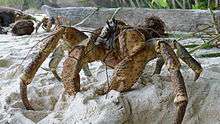
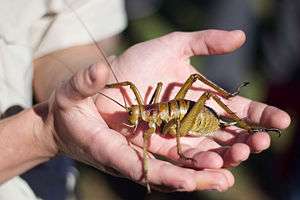
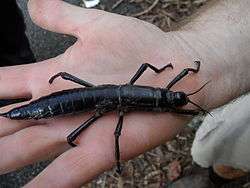
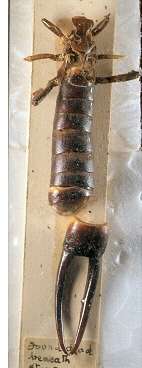
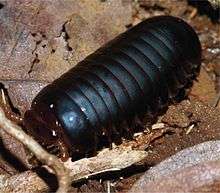
.jpg)
